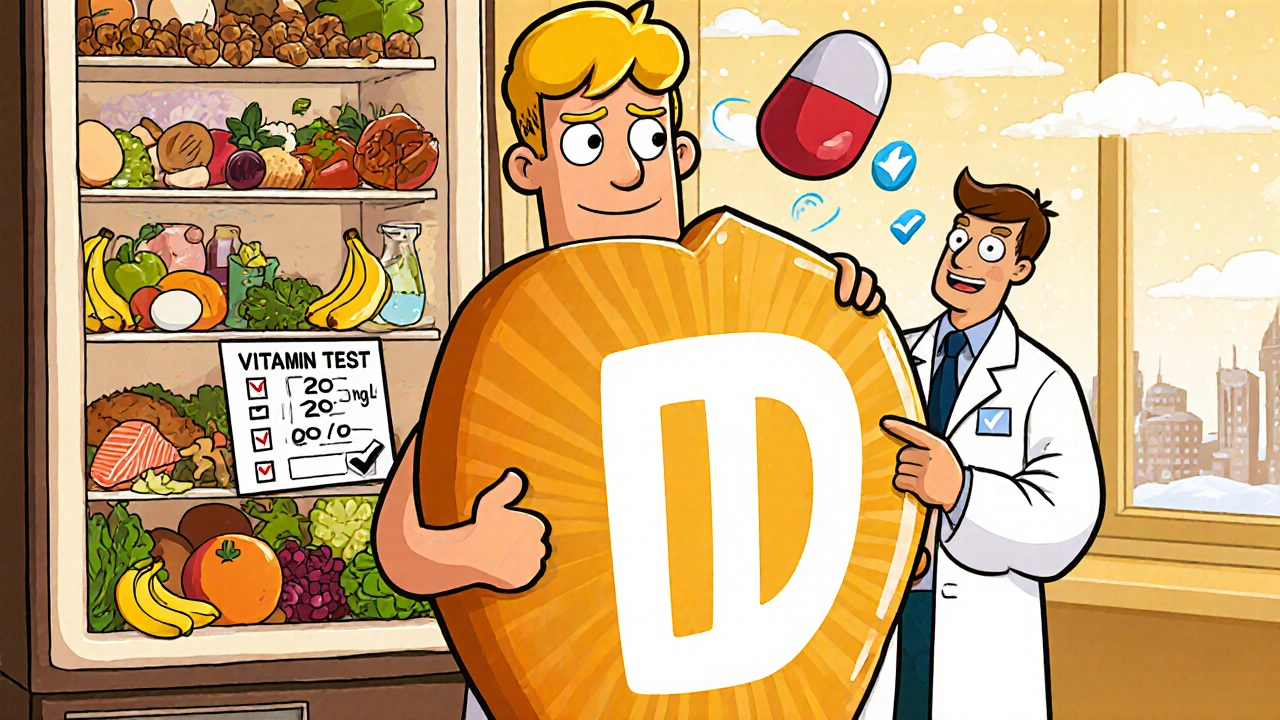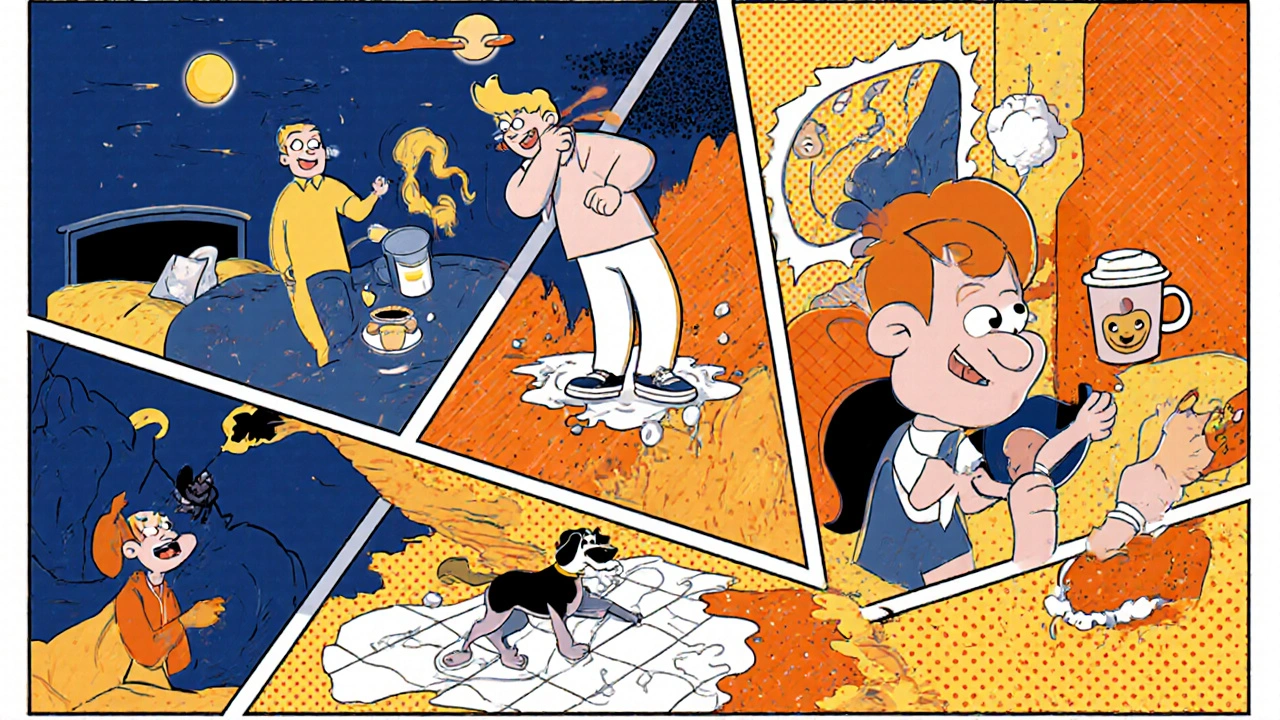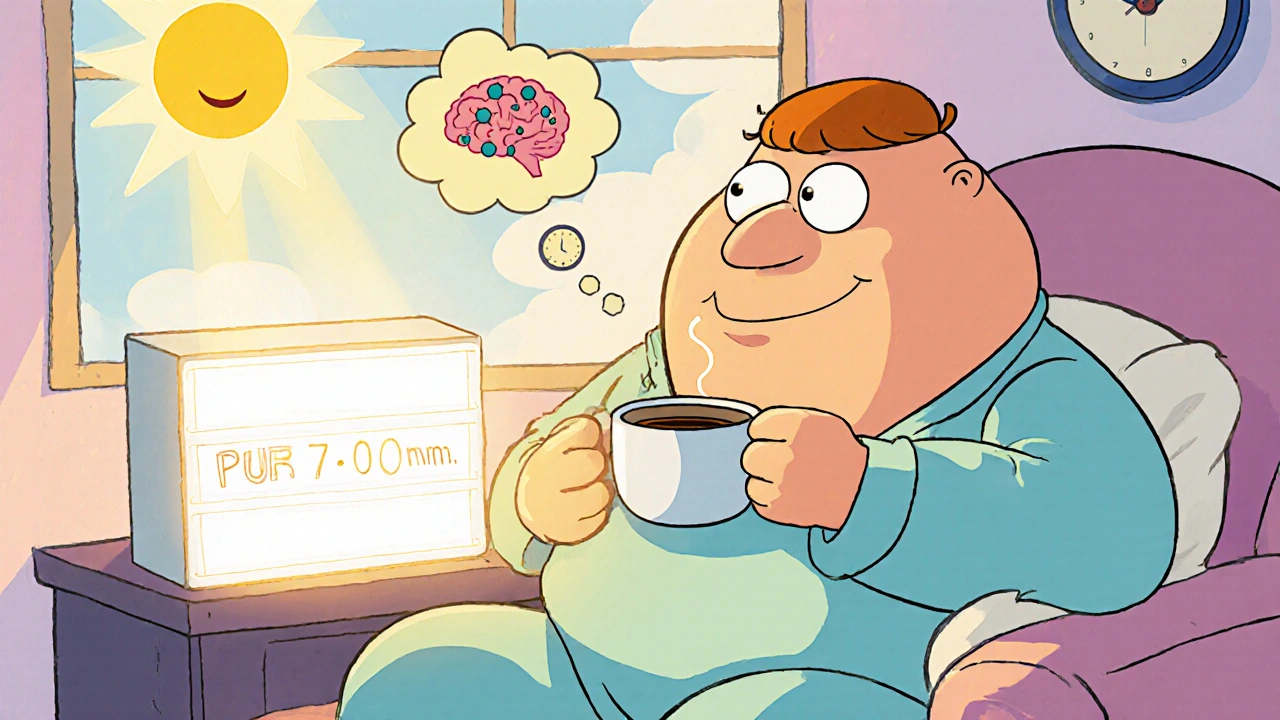Every year around this time, as the days get shorter and the mornings stay dark longer, many people start feeling off-not just tired, but flat, unmotivated, and emotionally drained. It’s not laziness. It’s not just "winter blues." For up to 5% of adults in the U.S., this is seasonal depression, a real and treatable condition known as Major Depressive Disorder with Seasonal Pattern. The good news? You don’t have to wait until you’re sinking to take action. Prevention works-and it starts with three simple, science-backed tools: light, vitamin D, and routine.
Light Isn’t Just for Seeing-It’s for Your Brain
Your body doesn’t just use light to see. It uses it to keep time. When daylight fades in the fall, your internal clock-called the circadian rhythm-gets confused. That throws off serotonin (your mood chemical) and messes with melatonin (your sleep hormone). The result? Low energy, oversleeping, cravings for carbs, and that heavy, hopeless feeling. The fix? Bright light therapy. Not a regular lamp. Not your phone screen. A specialized light box that delivers 10,000 lux of full-spectrum light, with minimal UV and strong blue wavelengths (460-480 nm). That’s about the intensity of being outside on a clear spring morning. You don’t need to stare at it. Just sit 16-24 inches away while you drink your coffee, read, or check emails. Do it within the first hour after waking. Twenty to thirty minutes a day is enough. Studies show most people feel better in just 1-2 weeks. And here’s the key: timing matters more than duration. Doing it too late in the day can mess up your sleep. Doing it too early can shift your rhythm the wrong way. Morning is the sweet spot. The Center for Environmental Therapeutics recommends starting light therapy in early fall-even before symptoms show up. People who begin in September cut their winter depression severity by 50-60%. If you can’t get a light box, get outside. Even on cloudy days, natural light is 10 times brighter than indoor lighting. Five to ten minutes of morning sunlight on your face or arms can help reset your clock. No need to burn. Just step out. Let your eyes catch the light.Vitamin D: The Missing Piece for Some
You’ve probably heard vitamin D is good for bones. But it’s also tied to serotonin production. When sunlight drops, so does your body’s ability to make vitamin D. Research shows people with levels below 20 ng/mL are at higher risk for depression. But here’s the catch: supplementing vitamin D doesn’t help everyone. If your levels are already normal, popping a pill won’t lift your mood. That’s why testing first makes sense. The Cleveland Clinic recommends checking your blood level before starting. If you’re under 20 ng/mL, 5,000 IU daily for a few months can help. If you’re between 20-30 ng/mL, 2,000 IU is usually enough. The Endocrine Society says 600-2,000 IU daily is safe for prevention. Most over-the-counter supplements are 1,000-2,000 IU. Take it with food-vitamin D is fat-soluble, so it absorbs better with a meal. And don’t stop at D. Foods that support serotonin-like eggs, lean chicken, spinach, bananas, and walnuts-help too. Omega-3s from salmon or flaxseed may also play a role. It’s not a magic bullet, but it’s one more layer of support.Routine: The Quiet Hero of Prevention
When you’re depressed, your schedule falls apart. You sleep in. You skip meals. You cancel plans. You stop moving. That’s a trap. The more you retreat, the worse the cycle gets. The antidote? Structure. Not perfection. Just consistency. Start with wake time. Set your alarm for the same time every day-even on weekends. No more than 30 minutes of variation. Your body craves predictability. The National Institute of Mental Health says this single habit stabilizes your circadian rhythm faster than almost anything else. Then, move. Thirty minutes of moderate activity-walking, cycling, dancing, even cleaning-every day. You don’t need to run a marathon. Just get your heart rate up. Exercise boosts serotonin and endorphins. It also helps you sleep better, which makes light therapy more effective. And don’t forget to plan things you enjoy. Social withdrawal is common in seasonal depression. Schedule a coffee with a friend. Watch a movie. Cook something new. The University of Vermont’s CBT-SAD program calls this "behavioral activation." It’s not about being happy. It’s about doing things that remind you life still has color. Combine these: wake up at 7 a.m., get 10 minutes of morning light, go for a walk, eat a balanced breakfast, plan one fun thing for the day. Repeat. It sounds simple. But repetition is what rewires your brain.
What Works Best? The Data Says
There’s no one-size-fits-all. But the science does show what works best for whom. - Light therapy gives the fastest results-often within days. Best for people who feel sluggish, sleep too much, and can’t wake up. It’s the most studied tool, with 70% of users seeing improvement. - CBT for SAD takes longer-4 to 6 weeks-but the effects last longer. People who learn to challenge negative thoughts and schedule activities are less likely to relapse. After two winters, only 45% of CBT users had a recurrence, compared to 60% of those using light alone. - Vitamin D helps only if you’re deficient. Don’t waste money on it if your levels are fine. But if you’re low, it’s a cheap, safe boost. - Combination is the strongest. A 2024 NIH-funded trial found that using light, vitamin D, and routine together reduced symptoms by 73%. That’s higher than any single method. If you’ve had seasonal depression before, don’t wait until you’re in crisis. Start now. September is the best time to begin.What Stops People From Getting Help?
The biggest problem isn’t lack of options. It’s lack of awareness. Most people don’t realize their winter slump is a medical condition. Primary care doctors miss it 65% of the time, often diagnosing it as general depression. That means people suffer for years without the right tools. Other barriers? Forgetting to use the light box. Skipping exercise when you’re tired. Thinking, "I’ll start tomorrow." That’s normal. But you can outsmart it. - Set a phone alarm labeled "Light Time" for 7 a.m. - Pre-schedule your walk with a friend. Accountability works. - Keep your light box next to your coffee maker. Make it part of your morning ritual. - Use a dawn simulator if you hate alarms. These devices slowly brighten your room over 90 minutes, mimicking sunrise. No jarring noise. Just gentle light to wake you naturally. The market for these tools is growing fast. Light therapy devices sold for $427 million in 2023. In Sweden, the government gives them out for free. In the U.S., more companies are offering "winter wellness" programs with light stations and flexible hours.







Joyce Genon
November 16, 2025 AT 07:51Okay but let’s be real-how many people actually stick to this? I tried light therapy for three days and then forgot about it because my coffee machine was in the wrong spot and I was too tired to move. And vitamin D? I took it for a week and my pee turned fluorescent. Not worth it. Also, who has time to wake up at 7 a.m. every day? I’m not a robot. This feels like a wellness influencer’s fantasy. Also, the article says ‘prevention works’ like it’s a guarantee. It’s not. It’s just a bunch of things that might help if you’re already motivated. And most people with SAD are too exhausted to be motivated. So congrats, you wrote a 2000-word guilt trip for people who are already drowning.
John Wayne
November 17, 2025 AT 18:16Light therapy at 10,000 lux? That’s just expensive placebo engineering. The real issue is the industrialization of seasonal affective disorder-pathologizing natural human rhythm adaptation. Our ancestors didn’t have light boxes. They slept more, ate more, and withdrew. It’s not a disorder. It’s an evolutionary strategy. And now we’re selling $300 lamps to people who just need to accept that winter is for hibernating. Also, ‘behavioral activation’? Sounds like corporate productivity jargon masquerading as mental health advice. The real cure? Stop pretending we’re meant to be productive year-round.
Julie Roe
November 19, 2025 AT 10:08I just want to say thank you for writing this. I’ve had SAD for over a decade and this is the first time I’ve read something that didn’t make me feel broken. I started using a light box last year in October and honestly? It changed everything. I didn’t think it would work, but I kept at it-even on days I didn’t feel like it. And the routine part? I started by just setting my alarm to the same time every day. No weekends off. No snoozing. It felt impossible at first, but after two weeks, my body just… adjusted. I still have bad days, but they’re not the same kind of heavy. Also, walking outside in the morning-even if it’s gray-makes a difference. I didn’t realize how much I was avoiding daylight until I started forcing myself to step outside. You don’t need to be perfect. You just need to show up. And if you’re reading this and feeling overwhelmed? Start with one thing. One morning. One five-minute walk. That’s enough. You’re not failing. You’re trying. And that matters.
jalyssa chea
November 19, 2025 AT 13:15so like i tried the light box and it made me dizzy and my eyes hurt and i thought maybe it was the cheap one i bought on amazon but then i read that you need to sit 16 inches away and i was like 2 feet away so maybe that was it but then i got lazy and now im back to sleeping till noon and eating cereal for dinner and i dont even care anymore because like why try if its just gonna make you feel worse and also vitamin d is a scam anyway i took it for a month and my skin got oily and my mood didnt change so maybe its all just hype and the real problem is capitalism and we all need to just quit our jobs and move to hawaii
Gary Lam
November 19, 2025 AT 17:25Y’all are treating this like it’s a DIY home renovation. Light box? Vitamin D? Routine? Nah. In Sweden, they just give you a free light box and a free therapist and tell you to take the weekend off. Here? We’re selling you $400 lamps and telling you to ‘just be consistent.’ Meanwhile, my boss still expects me to be ‘on’ at 9 a.m. even though I’m basically a zombie. Also, the article says ‘you don’t have to wait until you’re sinking.’ But what if you’re already sinking? And your insurance doesn’t cover any of this? I love that this is science-backed, but science doesn’t pay rent. Maybe we need to fix the system before we ask people to buy more stuff to fix it.
Peter Stephen .O
November 19, 2025 AT 21:47OMG YES. This is the most real thing I’ve read all year. I used to think I was just lazy until I learned about circadian rhythm disruption. Now I’ve got my light box next to my toaster, I walk with my dog every morning even if it’s freezing, and I take my D3 with my avocado toast. It’s not glamorous. It’s not Instagram-worthy. But it’s mine. And I’ve noticed something wild-I don’t dread November anymore. I used to spiral by Thanksgiving. Now I feel like I’m riding the wave instead of drowning in it. And the routine? It’s not about being perfect. It’s about being predictable. Your brain craves it like your body craves food. I started with just one thing: waking up at 7:15. No alarms. Just… I just did it. And now? I’m not fixed. But I’m not falling apart either. You don’t need to do all of this. Just do one thing. And do it again tomorrow. That’s how you outsmart the dark.
Andrew Cairney
November 21, 2025 AT 12:38Wait… so you’re telling me the government isn’t secretly controlling our moods with LED lighting in office buildings? 😏 I’ve been noticing how all the new office lights are blue-white since 2020… coincidental? I think not. Also, vitamin D? They’ve been pushing supplements since the 90s to make us forget that the real problem is fluoridated water + glyphosate in our food. And ‘routine’? That’s just social conditioning to keep us docile. Wake up at 7 a.m.? That’s the corporate schedule. I sleep when I’m tired. I move when I feel like it. And I refuse to be manipulated by light boxes designed by Big Wellness™. Also, the ‘dawn simulator’? That’s just a slow-mo alarm to trick your pineal gland. I’m onto you, wellness-industrial complex. 🤡
Rob Goldstein
November 23, 2025 AT 03:28As a clinical psychologist who specializes in mood disorders, I can confirm the data here is solid. Light therapy has Level 1 evidence for SAD, and the 70% response rate is replicated across multiple RCTs. Vitamin D supplementation only helps if serum 25(OH)D is <20 ng/mL-checking levels is non-negotiable. And routine? Circadian entrainment via fixed wake times is one of the most underutilized interventions in psychiatry. The NIH trial showing 73% symptom reduction with combination therapy? That’s the gold standard. For patients who don’t respond, I always screen for bipolar spectrum disorder-it’s commonly misdiagnosed as SAD. Also, digital CBT apps like SeasonWell? FDA-cleared, evidence-based, and free through some employer wellness programs. If you’re struggling, reach out to a provider. This isn’t ‘just winter blues.’ It’s a neurobiological rhythm disruption. And it’s treatable. You’re not broken. You’re just out of sync. And sync can be restored.